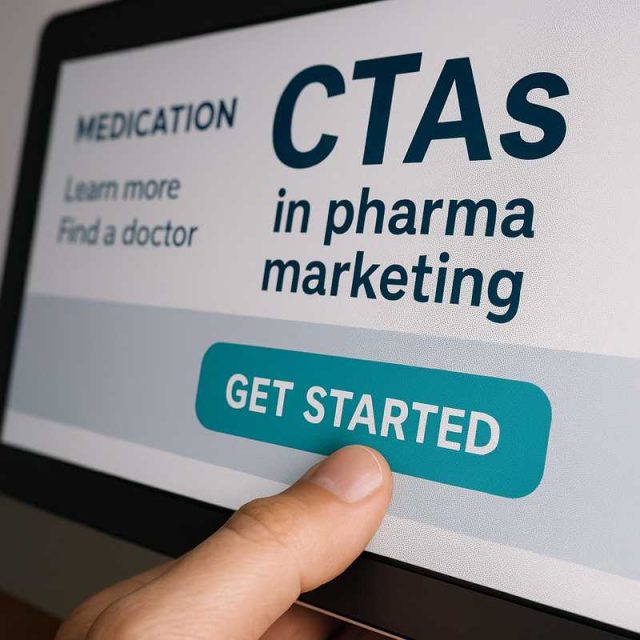In today’s crowded digital landscape, pharmaceutical brands face an increasingly complex task: turning awareness into action. While visibility remains important, engagement and conversion are what drive outcomes. That’s where CTAs (calls to action) come into play. For pharma marketers navigating strict compliance standards and shifting patient behavior, CTAs are not just marketing tools—they are essential strategic assets. But what makes CTAs more important now than ever before?
Table of Contents
The Evolution of Pharma Engagement
Personalized CTAs in Patient-Centric Strategies
CTAs in HCP-Focused Campaigns
The Digital Transformation and CTA Optimization
Conclusion
FAQs
The Evolution of Pharma Engagement
The way pharmaceutical brands engage healthcare providers (HCPs) and patients has changed dramatically. A decade ago, most communications occurred through in-person rep visits and print materials. Today, digital-first strategies dominate, emphasizing email marketing, display ads, social media, webinars, and branded content.
In this multichannel environment, CTAs guide audiences toward the next logical step—whether it’s downloading a clinical study, signing up for patient support, or starting a conversation with a sales representative. Without clear and compelling CTAs, even the most beautifully crafted content may fail to drive action. Furthermore, CTAs offer valuable data points by showing which messages resonate most and which channels perform best.
In pharma, where patient outcomes and provider decisions hinge on trust and clarity, CTAs must be concise, credible, and compliant. That means avoiding overt product promotion while still prompting engagement. Phrases like “Learn more about treatment options” or “Access patient savings info” strike the right tone.
Personalized CTAs in Patient-Centric Strategies
Modern pharma marketing puts patients at the center of the journey. However, patients don’t follow linear pathways—they move between awareness, education, action, and retention. CTAs act as signposts on this non-linear map, helping patients make informed decisions at every step.
For example, someone researching symptoms may benefit from a CTA like “Take our symptom checker,” while another user exploring branded drugs might respond to “Download the medication guide.” When CTAs reflect the user’s context and needs, they feel more like guidance than persuasion.
Personalization can significantly boost engagement. Using data from cookies, geolocation, or user behavior, pharma brands can tailor CTAs to individual visitors. A returning user might see “See how [Drug Name] compares to your current treatment,” whereas a new visitor might get “What is [Condition]? Learn more.”
Of course, compliance matters. All CTAs should align with FDA regulations and be vetted by MLR (Medical, Legal, Regulatory) teams. Still, that doesn’t mean sacrificing creativity or relevance. With careful planning, brands can create CTAs that are both effective and compliant.
CTAs in HCP-Focused Campaigns
Healthcare professionals are inundated with information. A strategic CTA can make the difference between ignored content and meaningful engagement. For instance, CTAs that lead to clinical trial data, peer-reviewed studies, or expert webinars offer real value and respect physicians’ time constraints.
When designing CTAs for HCPs, clarity and immediacy matter. Phrases like “Download Prescribing Info” or “Request a Rep Visit” perform better than vague options like “Click Here.” Additionally, using professional platforms like Doximity or LinkedIn enables targeted delivery of CTAs within trusted environments.
Integration across channels is also key. An email with the CTA “Watch KOL Insights on [Therapy Area]” can be paired with a landing page that continues the narrative and includes a secondary CTA like “Download Patient Resources.”
For campaigns involving branded products such as Dupixent or Jardiance, CTAs can include links to prescribing information, dosage calculators, or reimbursement tools—all of which facilitate informed decision-making and support the treatment journey.
The Digital Transformation and CTA Optimization
As pharma embraces digital marketing and programmatic advertising, the role of CTAs has expanded. Now, every ad, video, and web page is a potential engagement node. The best-performing campaigns constantly test and optimize CTAs to maximize conversion.
A/B testing allows marketers to experiment with language, placement, and design. Should the CTA say “Schedule a Consultation” or “Talk to a Specialist Today”? Testing provides the answers. Similarly, heatmaps and click-through metrics reveal how users interact with CTAs on a page.
CTAs are also central to omnichannel strategies. For example, a programmatic banner on a health site might prompt a CTA like “Learn more about your treatment options,” which leads to a branded microsite. From there, a CTA might encourage email sign-up or appointment scheduling. Each step is designed to move the user deeper into the funnel.
Furthermore, digital tools from companies like eHealthcare Solutions allow for more dynamic CTA delivery based on contextual data. Integrating CTAs into mobile apps, patient portals, and virtual assistants can provide real-time nudges tailored to user behavior.
You can find more pharma marketing insights on Pharma Marketing Network’s featured articles.
Conclusion
In the evolving landscape of pharma marketing, CTAs have never been more vital. They bridge the gap between content and conversion, guiding both patients and providers toward meaningful next steps. By making CTAs clear, contextual, and compliant, brands can improve engagement and drive better outcomes.
Today’s patients and HCPs expect intuitive experiences. Effective CTAs help meet those expectations. As digital transformation accelerates, pharma marketers must treat CTAs not as afterthoughts, but as critical components of a cohesive strategy.
FAQs
Why are CTAs important in pharma marketing?
CTAs guide users toward meaningful actions, improving engagement and outcomes in both patient- and provider-focused campaigns.
How can CTAs remain compliant with FDA guidelines?
By avoiding promotional claims and focusing on educational or support-oriented language, CTAs can stay effective while remaining compliant.
What makes a good CTA for HCPs?
Clear, specific language and professional relevance. Examples include “Download PI” or “Attend Expert Webinar.”
Can CTAs be personalized in pharma marketing?
Yes, using behavioral or location data to tailor CTAs improves relevance and conversion rates, provided privacy regulations are followed.
How do digital tools enhance CTA performance?
Through A/B testing, behavioral tracking, and omnichannel delivery, digital tools allow for more effective and targeted CTA deployment.
Disclaimer
“This content is not medical advice. For any health issues, always consult a healthcare professional. In an emergency, call 911 or your local emergency services.”
